Practice the questions of McGraw Hill Math Grade 8 Answer Key PDF Unit Test Lessons 7–9 to secure good marks & knowledge in the exams.
McGraw-Hill Math Grade 8 Unit Test Lessons 7–9 Answer Key
Round to the nearest tenth.
Question 1.
3406.997
Answer:
3407.0
Explanation:
If the digit in hundredth place is greater than 5 add 1 to the nearest tenth place.
So, 3406.997 is rounded to nearest tenth place is 3407.0
Question 2.
334,782.099
Answer:
334782.1
Explanation:
If the digit in hundredth place is greater than 5 add 1 to the nearest tenth place.
So, 334782.099 is rounded to nearest tenth place is 334782.1
Question 3.
65,529.0887
Answer:
65,529.1
Explanation:
If the digit in hundredth place is greater than 5 add 1 to the nearest tenth place.
So, 65,529.0887 is rounded to nearest tenth place is 65,529.1
Round to the nearest hundredth.
Question 4.
2,467,891.3554
Answer:
2,467,891.36
Explanation:
If the digit in thousandth place is greater than 5 add 1 to the nearest hundredth place.
So, 2,467,891.3554 is rounded to nearest hundredth place as 2,467,891.36
Question 5.
97.009
Answer:
97.01
Explanation:
If the digit in thousandth place is greater than 5 add 1 to the nearest hundredth place.
So, 97.009 is rounded to nearest hundredth place 97.01
Round to the nearest ten thousandth.
Question 6.
17.99986
Answer:
17.9999
Explanation:
If the digit in lakh place is greater than 5 add 1 to the nearest ten thousandth place.
So, 17.99986 is rounded to nearest ten thousandth place 17.9999
Question 7.
99.11115
Answer:
99.1112
Explanation:
If the digit in ten thousandth place is greater than 5 add 1 to the nearest thousandth place.
So, 99.11115 is rounded to nearest thousandth place 99.1112
Identify the place value of the underlined number.
Question 8.
1,683,679.57344
Answer:
4 is in ten thousandth place.
Explanation:
In decimals place value follows immediate right to the decimal starting from tenths place,
followed by hundredth, thousand , ten thousand and so on places.
So, count the numbers after the decimal and then write the place values as explained above.
Question 9.
1,499,667.5773
Answer:
7 is in hundredth place.
Explanation:
In decimals place value follows immediate right to the decimal starting from tenths place,
followed by hundredth, thousand , ten thousand and so on places.
So, count the numbers after the decimal and then write the place values as explained above.
Convert the decimal to a fraction.
Question 10.
.8 = _____________
Answer:
\(\frac{8}{10}\)
Explanation:
Use the place value farthest to the right as denominator,
the decimal number becomes the numerator.
0.8 = \(\frac{8}{10}\)
Question 11.
.875 = _____________
Answer:
\(\frac{7}{8}\)
Explanation:
Use the place value farthest to the right as denominator,
the decimal number becomes the numerator.
0.875 = \(\frac{875}{1000}\)
simplify both numerator and denominator with 5
= \(\frac{175}{200}\)
= \(\frac{35}{40}\)
= \(\frac{7}{8}\)
Question 12.
.08 = _____________
Answer:
\(\frac{8}{100}\)
Explanation:
Use the place value farthest to the right as denominator,
the decimal number becomes the numerator.
0.08 = \(\frac{8}{100}\)
Convert the fraction to a decimal.
Question 13.
\(\frac{3}{5}\) = _____________
Answer:
0.6
Explanation:
To convert fraction into decimal divide the numerator with denominator.
\(\frac{3}{5}\) = 0.6
Question 14.
\(\frac{8}{15}\) = ______________
Answer:
0.53
Explanation:
To convert fraction into decimal divide the numerator with denominator.
\(\frac{8}{15}\) = 0.53
Question 15.
\(\frac{3}{16}\) = _______________
Answer:
0.18
Explanation:
To convert fraction into decimal divide the numerator with denominator.
\(\frac{3}{16}\) = 0.18
Put the decimals in order from least to greatest.
Question 16.
.122, .1145, .616, .6165, .513, .3132, .2126, .819
Answer:
.1145, .122, .2126, .3132, .513, .616, .6165, .819
Explanation:
First arrange the decimals one beneath the other in their original order,
.122,
.1145,
.616,
.6165,
.513,
.3132,
.2126,
.819
Next examine each decimal writing one or more zeros to the right of the last digit.
.12200,
.11450,
.61600,
.61650,
.51300,
.31320,
.21260,
.81900
So, that all decimals will have the same number of digits.
Then order the decimals from least to the greatest.
.1145, .122, .2126, .3132, .513, .616, .6165, .819
Question 17.
.217, .0217, .0133, .0487, .1243, .20413, .5257, .05257, .05205
Answer:
.0133, .0217, .0487, .05205, .05257, .1243, .20413, .217, .5257
Explanation:
First arrange the decimals one beneath the other in their original order,
.217,
.0217,
.0133,
.0487,
.1243,
.20413,
.5257,
.05257,
.05205
Next examine each decimal writing one or more zeros to the right of the last digit.
.21700,
.02170,
.01330,
.04870,
.12430,
.20413,
.52570,
.05257,
.05205
So, that all decimals will have the same number of digits.
Then order the decimals from least to the greatest.
.0133, .0217, .0487, .05205, .05257, .1243, .20413, .217, .5257
Add or Subtract.
Question 18.

Answer:
3.472817
Explanation:
First line up all the addends according to their place value,
then ignore the decimals and add all the whole numbers to get the sum.
Finally count the number of decimals and put in the sum.

Question 19.

Answer:
6.53518656
Explanation:
First line up all the addends according to their place value,
then ignore the decimals and add all the whole numbers to get the sum.
Finally count the number of decimals and put in the sum.

Question 20.
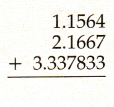
Answer:
6.660933
Explanation:
First line up all the addends according to their place value,
then ignore the decimals and add all the whole numbers to get the sum.
Finally count the number of decimals and put in the sum.
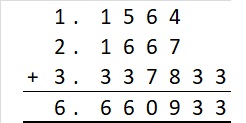
Question 21.

Answer:
1.91916
Explanation:
Explanation:
First line up all the decimals according to their place values,
then insert zeros in placeholders if needed to calculate.

Question 22.

Answer:
1.428711
Explanation:
Explanation:
First line up all the decimals according to their place values,
then insert zeros in placeholders if needed to calculate.

Question 23.

Answer:
2.24946656
Explanation:
Explanation:
First line up all the decimals according to their place values,
then insert zeros in placeholders if needed to calculate.

Question 24.

Answer:
$6.75
Explanation:
First line up all the addends according to their place value,
then ignore the decimals and add all the whole numbers to get the sum.
Finally count the number of decimals and put in the sum.

Question 25.

Answer:
$2.78
Explanation:
First line up all the addends according to their place value,
then ignore the decimals and add all the whole numbers to get the sum.
Finally count the number of decimals and put in the sum.

Multiply or Divide.
Question 26.

Answer:
36.297
Explanation:
while multiplying decimals ignore the decimals in the factors and multiply,
then count total number of decimal places in the factors.
Starting from the right of the product count the number of places,
then put the decimal point to the left of the last place.
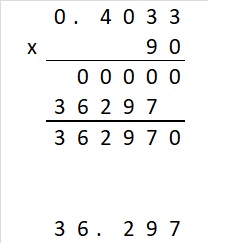
Question 27.

Answer:
2,119.175
Explanation:
while multiplying decimals ignore the decimals in the factors and multiply,
then count total number of decimal places in the factors.
Starting from the right of the product count the number of places,
then put the decimal point to the left of the last place.
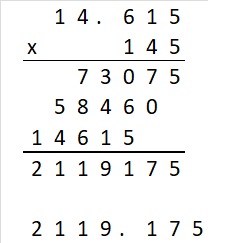
Question 28.
![]()
Answer:
$0.1068
Explanation:
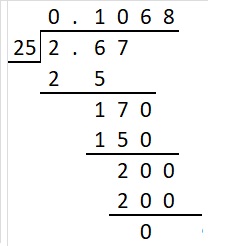
Question 29.

Answer:
7.48935
Explanation:
while multiplying decimals ignore the decimals in the factors and multiply,
then count total number of decimal places in the factors.
Starting from the right of the product count the number of places,
then put the decimal point to the left of the last place.
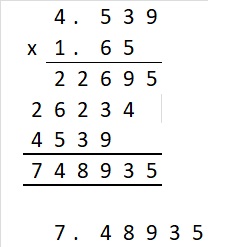
Question 30.

Answer:
$91.84
Explanation:
while multiplying decimals ignore the decimals in the factors and multiply,
then count total number of decimal places in the factors.
Starting from the right of the product count the number of places,
then put the decimal point to the left of the last place.
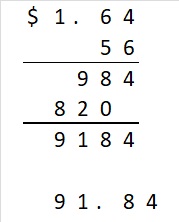
Question 31.

Answer:
2.9768005
Explanation:
while multiplying decimals ignore the decimals in the factors and multiply,
then count total number of decimal places in the factors.
Starting from the right of the product count the number of places,
then put the decimal point to the left of the last place.
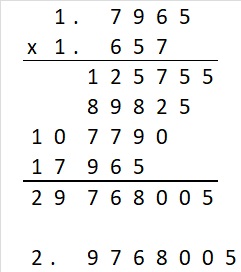
Question 32.

Answer:
$2.3625
Explanation:
while multiplying decimals ignore the decimals in the factors and multiply,
then count total number of decimal places in the factors.
Starting from the right of the product count the number of places,
then put the decimal point to the left of the last place.
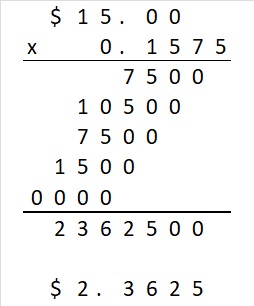
Question 33.
![]()
Answer:
1.478625
Explanation:
multiplying by 1000000 on both numbers to remove decimals,
24 x 1000000 = 250
0.5805 x 1000000 = 5805
After dividing count the number of decimals in divisor and place in the quotient or answer.
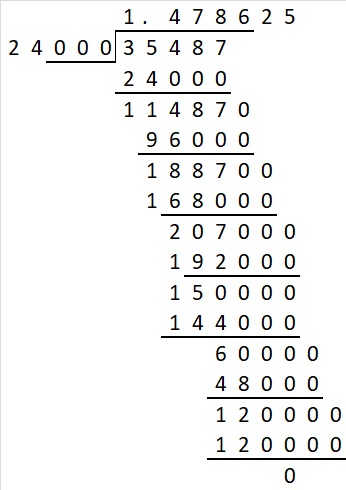
Question 34.
![]()
Answer:
6.38080
Explanation:
multiplying by 100000 on both numbers to remove decimals,
2.24 x 100000 = 2240
14.293 x 100000 = 14293
After dividing count the number of decimals in divisor and place in the quotient or answer.
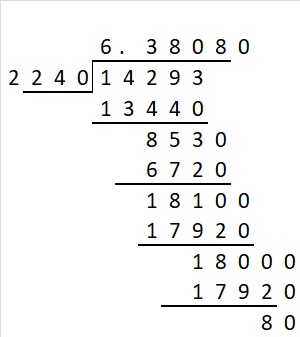
Question 35.
![]()
Answer:
11.6956
Explanation:
multiplying by 100 on both numbers to remove decimals,
0.23 x 100 = 25
2.69 x 100 = 269
After dividing count the number of decimals in divisor and place in the quotient or answer.
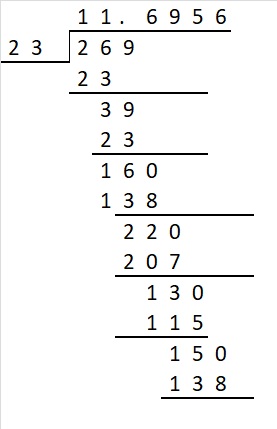
Question 36.
![]()
Answer:
23.22
Explanation:
multiplying by 10000 on both numbers to remove decimals,
0.025 x 10000 = 250
0.5805 x 10000 = 5805
After dividing count the number of decimals in divisor and place in the quotient or answer.
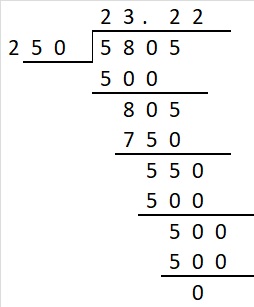
Question 37.

Answer:
0.383135
Explanation:
while multiplying decimals ignore the decimals in the factors and multiply,
then count total number of decimal places in the factors.
Starting from the right of the product count the number of places,
then put the decimal point to the left of the last place.
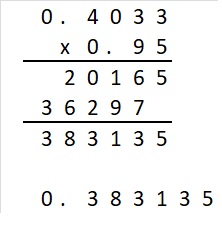
Question 38.

Answer:
234.225
Explanation:
while multiplying decimals ignore the decimals in the factors and multiply,
then count total number of decimal places in the factors.
Starting from the right of the product count the number of places,
then put the decimal point to the left of the last place.
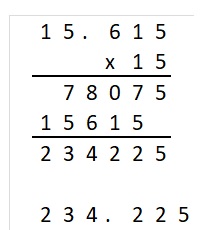
Question 39.
![]()
Answer:
$0.25
Explanation:
while multiplying decimals ignore the decimals in the factors and multiply,
then count total number of decimal places in the factors.
Starting from the right of the product count the number of places,
then put the decimal point to the left of the last place.
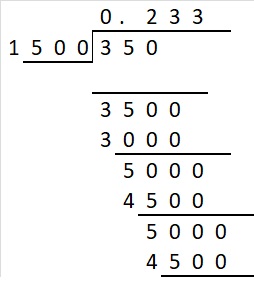
Question 40.

Answer:
6.65405
Explanation:
while multiplying decimals ignore the decimals in the factors and multiply,
then count total number of decimal places in the factors.
Starting from the right of the product count the number of places,
then put the decimal point to the left of the last place.
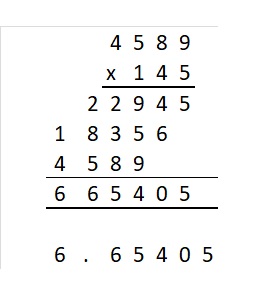
Question 41.

Answer:
$1.027
Explanation:
while multiplying decimals ignore the decimals in the factors and multiply,
then count total number of decimal places in the factors.
Starting from the right of the product count the number of places,
then put the decimal point to the left of the last place.

Question 42.
Chad and his service club collected a total of 954.75 pounds of canned food for the local animal shelter. There are 15 people in the club. If each member collected the same amount of canned food, how many pounds did each member collect?
_____________ pounds
Answer:
63.65 pounds
Explanation:
Chad and his service club collected a total of 954.75 pounds of canned food for the local animal shelter.
There are 15 people in the club.
If each member collected the same amount of canned food,
Number of pounds did each member collect 954.75 ÷ 15 = 63.65 pounds
Question 43.
Jane went to the store to buy food for a party of 6 neighbors. For each guest, she spent $2.55 for salad, $1.75 for a cold beverage, and $1.25 for a fruit cup. How much did she spend in total to buy the food? __________________
Jane has $35. Does she have enough money to buy everything she needs? __________________
If so, then how much change will Jane get back? __________________
Answer:
Money spent to buy on food $5.55
Yes, she has enough money to buy food.
Jane will get a change of $29.45
Explanation:
Jane went to the store to buy food for a party of 6 neighbors.
For each guest, she spent $2.55 for salad, $1.75 for a cold beverage, and $1.25 for a fruit cup.
She spend in total to buy the food $2.55 + $1.75 + $1.25 = $5.55
Jane has $35.
Does she have enough money to buy everything she needs $35 – $5.55 = $29.45
Total change will Jane get back $35 – $5.55 = $29.45
Question 44.
Rodney runs on a cross-country course that is 2.35 miles in length. During the week he ran the course 5\(\frac{1}{2}\) times. How far did he run that week?
Answer:
12.925 miles
Explanation:
Rodney runs on a cross-country course that is 2.35 miles in length.
During the week he ran the course 5\(\frac{1}{2}\) times
= \(\frac{11}{2}\) = 5.5
Number of miles he runs in the week = 2.35 x 5.5 = 12.925 miles
Question 45.
Stan is preparing pots for planting flowers. He has 23.5 pounds of potting soil. If Stan fills each pot with 1.35 pounds of potting soil, how many pots can he fill?
Answer:
17 pots
Explanation:
Stan has 23.5 pounds of potting soil.
If Stan fills each pot with 1.35 pounds of potting soil,
Number of pots he fill 23.5 ÷ 1.35 = 17.407 or 17 pots
Question 46.
Billy charges 45ยข per square foot to varnish patio decks. If the patio deck he is varnishing is 220.25 square feet in area, how much should Billy charge for the job?
Answer:
9,911.25 ยข per square foot
Explanation:
Billy charges 45ยข per square foot to varnish patio decks.
If the patio deck he is varnishing is 220.25 square feet in area,
Total amount Billy charge for the job 45 x 220.25 = 9,911.25
Question 47.
Tacy mixed cold beverages for all of the teams participating in a local baseball tournament. For each batch, she mixed 3.25 gallons of lemonade with 1.3 gallons of iced tea. If Tracy made 8\(\frac{3}{4}\) batches, how many gallons of cold beverage did she make?
______________ gallons
Answer:
Explanation:
For each batch, Tacy mixed 3.25 gallons of lemonade with 1.3 gallons of iced tea.
3.25 + 1.3 = 4.55
If Tracy made 8\(\frac{3}{4}\) batches,
\(\frac{35}{4}\) = 8.75 batches.
So, number of gallons of cold beverage she make 4.55 x 8.75 = 39.8125